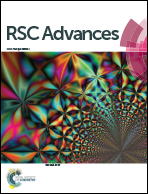Synthesis and click modification of an azido-functionalized Zr(iv) metal–organic framework and a catalytic study†
Abstract
An azido-functionalized Zr(II) metal–organic framework (MOF), UiO-67–N3, was synthesized from 2-azidobiphenyl-4,4′-dicarboxylic acid. During the synthesis, the ligand can undergo in situ thermocyclization to give 9H-carbazole-2,7-dicarboxylic acid. It proved that UiO-67–N3 can be obtained at relatively low temperature without ligand transformation. Post-synthetic modification of UiO-67–N3 was successfully performed via the click reactions between the azido group and different alkyne compounds to produce new MOFs with different functionalities, UiO-67–Tz–X with X = COOCH3, OH and NH2. These clicked MOFs, especially UiO-67–Tz–NH2, exhibit better stability than the mother material UiO-67–N3. The catalytic properties of the clicked MOFs were studied using the Knoevenagel condensation reactions between benzaldehyde and different methylene compounds. Only the NH2-functionalized MOF is active, suggesting that the amino group, rather than the triazole group or any other component of the framework, is the crucial active site. The catalysis is heterogeneous. The MOF is recyclable for the reaction with malononitrile but not for the reaction with ethyl cyanoacetate. The deactivation in the latter case is proposed to be because the amino site reacts with the ester group of ethyl cyanoacetate to form amide.


 Please wait while we load your content...
Please wait while we load your content...